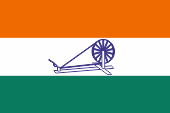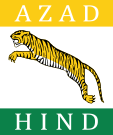mobile View, to the German Version tap the flag

- 1943–1945
- Provisional Government of Free India
- allied with the Axis powers of the Second World War
• Flags
• Meaning/Origin of the Flag
• Numbers and Facts
• History

1943–1945,
Azad Hind,
Flag of the Provisional Government of the Free India,
Source, by:
Wikipedia (EN)




1943–1945,
Azad Hind,
Flag of the Indian National Army,
Source, by:
Wikipedia (D)




The flag of the Indian National Congress – orange-white-green with a spinning wheel (see illustration) served as national and war flag of the "Provisional Government of the Free India (Azad Hind)" under Subhas Chandra Bose, which was allied with the Axis powers. In Germany had meanwhile been set up the "Legion of Free India" - about as large as a regiment. Their flag was orange-white-green striped and showed the inscription "Azad Hind" and a jumping tiger, as well as the sleeve badge on the German tropical uniform of the army.
Source:
Jürgen Kaltschmitt → Wikipedia (EN)

Troop strength: 90.000
Seat of the gouvernment: on the Andaman and Nicobar Islands
Source:
Jürgen Kaltschmitt → Wikipedia (EN)

The flag of the Indian National Congress – orange-white-green with a spinning wheel
(see illustration) served as national and war flag of the "Provisional
Government of the Free India (Azad Hind)" under Subhas Chandra Bose, which was
allied with the Axis powers.
The seat of the government of the
Provisional Government of the Free India under Subhas Chandra Bose was on Indian
territory, on the by the Japanese occupied Andaman and Nicobar Islands, which
were also the headquarters of the Indian National Army (INA, 90.000 men).
During the India offensive of the 15th Japanese Army (from Burma, in 1944),
the INA in Northeast India achieved temporarily to free parts of Manipur and
Nagaland.
The INA used captured British steel helmets, British handguns,
British uniforms, the commanding language was English. It was, so to speak, a
reflection of the British-Indian army, i.e. the colonial power was, as in so
many third world states, style-forming, it had to be, because many peoples lived
together within a colony that did not have too many similarities. In order to be
recognized and perceived as an Indian NATIONAL army by their own compatriots, an
interesting proposal came from the Japanese liaison officers. The head of the
troops, like the Japanese infantry and its commanders in the Middle Ages, has to
show short poles with small flags attached to the man, so-called "Nobari" or
"Sashimono" (picture → click here). Of course, not with Japanese motifs, such as
the "Mon" of a general, but the colours of the Indian National Congress. That's
what happened. And became a complete success. The existence of the INA could no
longer be denied by the British.
After the battle of Imphal, the Japanese
and the Indian National Army finally had to retreat.
In Germany had been
set up the "Legion of Free India" - about as large as a regiment. Their flag was
orange-white-green striped and showed the inscription "Azad Hind" and a jumping
tiger, as well as the sleeve badge on the German tropical uniform of the army.
After the D-Day invasion it was withdrawn from the Atlantic Wall in 1944. On
the way back to Germany, the Legion of Free India had a number of battles
against French partisans and regular Gaullist units. The awards that had been
given to the legionaries were therefore well-earned.
At the capitulation
of Japan and also of the INA, it came to fraternities between units of the
British Indian Army and the Indian National Army – ensued to the horror of the
British.
The existence of the INA was nearly unknown within
India because
of the total news blackout in India during the war, just as the fact that in
1944 about one million Indians had starved to death in Bengal, because the
British, like the Soviets, had only the food for people who could fight and / or
work.
In 1946, the British tried to condemn the INA Officers in the
so-called "Red Fort Processes" for high treason. Vain. Major parts of the
British Indian Army were passive, there were considerable civil unrests, the
British-Indian navy and the British-Indian air force mutinied and were no longer
operational.
It was one of the by the British claimed points of the
Indian Independence from Great Britain that no former INA members should be
admitted into the army of the independent India. As there was "only" mentioned
the army, INA members were gladly taken over to the police, the border guards,
the air force, the navy and the diplomatic service. The first ambassador of
independent India in the Federal Republic of Germany was a legionary of the
"Free India".
Even today there are Indian (and also Pakistani)
politicians who believe that only two men had the strength and the charisma to
prevent the breakup of British India into the two states of India
and Pakistan.
On the one hand: Ghandi. On the other hand: Subhas Chandra Bose.
Source:
Jürgen Kaltschmitt → Wikipedia (EN), Youtube


![]()






